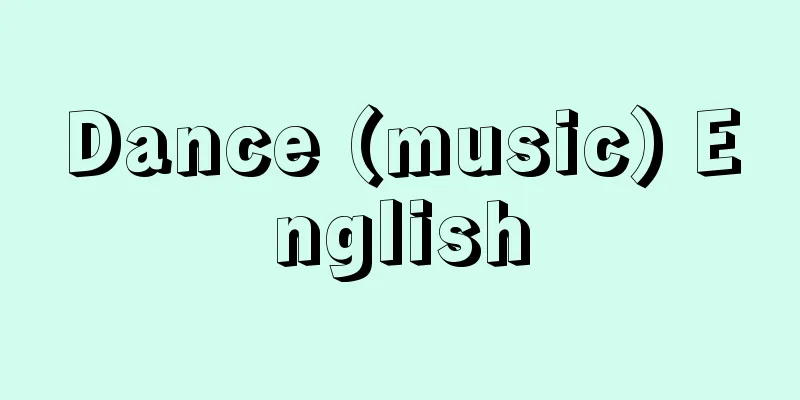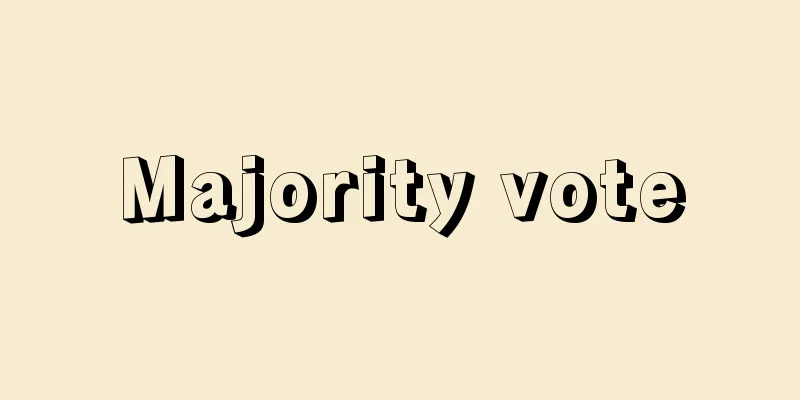Dance (music) English

|
Originally it meant music to accompany dance, but it also includes music that was created for the sole purpose of appreciation, separate from dance. Dance music comes in a variety of forms, including those that use the human body, such as clapping or stomping, those that are vocal only, those that combine vocal and instrumental music, and those that are instrumental only. Although "dance music" is sometimes limited to Western music, this article will provide an overview that also includes Latin American music, which has had a global influence in recent years. [Ryuichi Tai] European DanceSince the Middle Ages, various dances have appeared, but a kind of circular action has been observed in European dances, where dances performed by the people were adopted by the royal courts and then popularized by the people again. The 16th century in particular is called the "century of dances," and many dances appeared, such as the allemande (moderate 4/4 time), the courante (fast triple time), the pavane (slow duo time), and the gagliarda (lively triple time). Slow and fast dances were often performed as a pair (for example, allemande and courante). In the 17th century, dance suites that combine several dances (for example, allemande-courante-sarabande-gigue) appeared. The famous Orchestral Suites by J.S. Bach are also based on this form. Around this time, French dances such as the bourrée (fast duple time), gavotte (medium duple time), and menuet (slow 3/4 time) became popular. The minuet in particular was later incorporated into string quartets and symphonies. The dances mentioned above are still handed down today as folk dances in various regions, and some of the most famous are the gigg from Scotland, the bourrée from Languedoc in France, and the gavotte from Brittany. In the 19th century, the moderate 3/4 waltz (the most representative of which is the Viennese waltz) became all the rage, and dances from outside Western Europe also became popular. Notable examples include the Polish mazurka (a general term for dances in 3/4 from the Mazur region, including the slow kujawiak and the fast oberek), the polonaise (a gentle 3/4), and the polka (a fast 2/4) from the Czech Republic and Bohemia. In the 20th century, dances from African-American music in the United States and Latin American dances came into the spotlight. [Ryuichi Tai] Latin American DanceDances play an extremely important role in Latin American music, and many of them have had a global impact, especially since the 20th century, with the development of mass media. Among the representative dances of each region, Mexico's son is a general term for dances in 6/8 time, and each region has its own unique son. The huapango from the Huasteca region and the son jarocho from Veracruz are particularly famous. Cuba has produced many dances and rhythms in recent years, which have become popular worldwide. Representative examples are the bolero, habanera, r(h)umba, cha-cha-chá, and mambo (all in 2/4 time). In Brazil, the samba, a dance used in the costume parade at carnival, is world famous. In Peru, there is the huaino, a dance in two beats that is said to be unique to the Indians, and the zamacueca, a 6/8 time dance centered in Lima. In recent years, the vals peruano, a unique waltz with a lot of syncopation, has become popular. In addition to the famous tango, Argentina has many other dances, such as the chacarera and the zamba (both in 6/8 time). [Ryuichi Tai] [References] | | | | | | | | | | | | | | | |MamboSource: Shogakukan Encyclopedia Nipponica About Encyclopedia Nipponica Information | Legend |
|
本来は舞踊のための伴奏音楽をいうが、舞踊を離れて、純粋に音楽のみを鑑賞するためにつくられたものも含まれる。舞曲には、手拍子や足踏みなど人間の身体を使用するものや、声楽だけによるもの、声楽と器楽を併用したり組み合わせるもの、器楽だけによるものなど多様な形態がある。なお「舞曲」を西洋音楽に限定していう場合もあるが、ここでは近年、世界的に影響を与えているラテンアメリカのものを含めて概観する。 [田井竜一] ヨーロッパの舞曲中世以来、さまざまな舞曲が現れたが、民間で行われている舞曲が宮廷にも取り入れられ、さらにそれがふたたび民間でもてはやされるといった一種の循環作用があるのが、ヨーロッパの舞曲の一般的な特徴である。とくに16世紀は「舞踊の世紀」とよばれ、アルマンドallemande(中庸の4/4拍子)、クーラントcourante(速い三拍子)、パバーヌpavane(ゆっくりとした二拍子)、ガリアルダgagliarda(快活な三拍子)など、数多くの舞曲が登場した。また、遅い舞曲と速い舞曲が一対の組として(たとえばアルマンドとクーラント)演奏されることも多かった。また17世紀になると、いくつかの舞曲を組み合わせる舞踊組曲(たとえばアルマンド―クーラント―サラバンドsarabande―ジーグgigue)が現れた。有名なJ・S・バッハの『管弦楽組曲』もこの形式によっている。さらにこのころ、ブレbourrée(速い二拍子)、ガボットgavotte(中庸の二拍子)、メヌエットmenuet(ゆっくりとした3/4拍子)などフランス系の舞曲が流行した。とくにメヌエットはその後、弦楽四重奏曲や交響曲などにも取り入れられるようになった。また以上あげた舞曲は、民族舞曲として今日でも各地で伝承されており、イギリス・スコットランド地方のジグーgigg、フランス・ラングドック地方のブレやブルターニュ地方のガボットなどが有名である。 19世紀になると、中庸の3/4拍子であるワルツwaltz(その代表がウィンナ・ワルツである)が一世を風靡(ふうび)したほか、西ヨーロッパ以外の地域の舞曲が流行した。たとえばポーランドのマズルカmazurek(マズル地方の三拍子系の舞曲の総称で、ゆっくりとしたクヤウィアクkujawiakや急速なオベレクoberekなどが含まれる)やポロネーズpolonaise(穏やかな3/4拍子)、チェコ・ボヘミア地方のポルカpolka(速い二拍子)などがその代表的な例である。20世紀に入ると、アメリカ合衆国の黒人系音楽の舞曲や、ラテンアメリカの舞曲が脚光を浴びるようになった。 [田井竜一] ラテンアメリカの舞曲ラテンアメリカ音楽において舞曲はきわめて重要な位置を占め、とくに20世紀に入ってからはマス・メディアの発達に伴って世界的に影響を与えているものも多い。各地域の代表的な舞曲をあげると、メキシコのソンsonは6/8拍子の舞曲の総称で、各地方に特色のあるソンがある。とくにウアステカ地方のウアパンゴhuapango、ベラクルス地方のソン・ハローチョson jarochoが有名である。キューバは近年多くの舞曲ないしはリズムを生み出しており、それらは世界的に流行している。その代表的な例はボレロbolero、ハバネラhabanera、ルンバr(h)umba、チャチャチャcha cha chá、マンボmambo(いずれも2/4拍子系)である。ブラジルにおいては、カーニバルの仮装パレードの舞曲であるサンバsambaが世界的に有名である。ペルーには、インディオ固有の舞曲といわれる二拍子系のウアイノhuainoや、リマを中心とする6/8拍子の舞曲サマクエッカzamacuecaがある。また近年は、シンコペーションの多い独特のワルツであるバルスペルアーノvals peruanoが流行している。アルゼンチンには有名なタンゴtangoのほか、チャカレラchacareraやサンバzamba(ともに6/8拍子)など多数の舞曲がある。 [田井竜一] [参照項目] | | | | | | | | | | | | | | | | | |出典 小学館 日本大百科全書(ニッポニカ)日本大百科全書(ニッポニカ)について 情報 | 凡例 |
<<: Dance Fan Forest - Bukyo Senrin
Recommend
Night Heron (Goisagi) - Night Heron
A bird of the heron family. Wingspan 29cm. Green-b...
Yuzu (Citrus junos Sieb.ex Tanaka)
An evergreen tree of the Rutaceae family, it is a ...
Usuda Arou - Usuda Arou
Haiku poet. Born in Nagano Prefecture. Real name ...
Providence - Providentia (Latin)
The idea that God's will takes care of and ma...
Transposon
…Eukaryotic cells also have small circular DNA ou...
Dhammapāla - Dhammapāla (English spelling)
A commentator of the Southern Theravada Mahavihara...
Tamaki [town] - Tamaki
A town in the southern part of the Ise Plain, Wata...
Edo Uchiwa Fan - Edo Uchiwa Fan
…Festival fans and dance fans were sometimes made...
Uchino (Fukuoka) - Our
…The western to southern part of the prefecture i...
"Gishinden Yomikirikousha" - A short story
...The next most famous work is "Taiheiki Ch...
Van der Decken (English spelling)
...It appears in the sea around the Cape of Good ...
Amaranthus paniculatus (English spelling) Amaranthuspaniculatus
…[Tetsuichi Yahara]. … *Some of the terms mention...
Kanshinji Temple Golden Hall
...The main hall of Kakurin-ji Temple in Hyogo (a...
Delphinium
A general term for the genus Delphinium in the Ra...
Loach scooping - Loach scooping
This dance is based on the folk song "Yasugi-...









